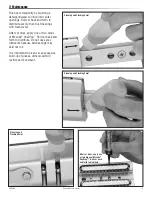
11/01/10
External Access System
17
ANNEX 2
PROTECTION AGAINST FALLS FROM A HEIGHT – ANCHOR DEVICES –
REQUIREMENTS AND TESTING
1. Anchor devices fitted on vessels must comply with EN795; 1996; Class D or similar.
2. The main requirements are that tests should be carried out on a sample of the medium to
which the anchor devices, in this case the traveller and bar to which it is attached.
3. A static test with a weight of 10kN should be applied for a period of no less than 3 minutes.
If there is more than one traveller, ie more than one load can be carried, an additional 1kN
for each attachment should be added. The device should suffer no distortion or damage.
4. A dynamic test consists of a 100kg mass being dropped a distance of 2.5m between the
anchor points of the traveller bar. Again there should be no damage to the structure. This
test should be repeated at the extreme anchor points and at an intermediate one.
5. Precise descriptions of the required tests can be found in BS EN 795:1997.
6. Below is an example of a traveller showing its construction.
Lanyard Attachment Points
End stop
Tandem C
(Optional Equipment Car
Track Rail
. Below is a typical setup for attachments to the traveller.
.Full-Body Safety Harness
ched to the
. Working Harness
chair attached to
dditional Options
traveller or
ar
& Connector Plate)
7
1
Use a full-body safety harness atta
access traveller with lock.
ust meet
Full-body safety harness m
CE
/ANSI support standards.
2
Use a working harness or
the access traveller without lock.
et
Working harness or chair must me
CE
/ANSI support standards.
A
3. Tool Service Car
Add an optional lockable
traveller with coupler to work
as your tool service carrier.
- 6 -
Appendix A





























